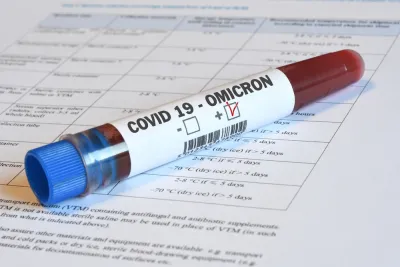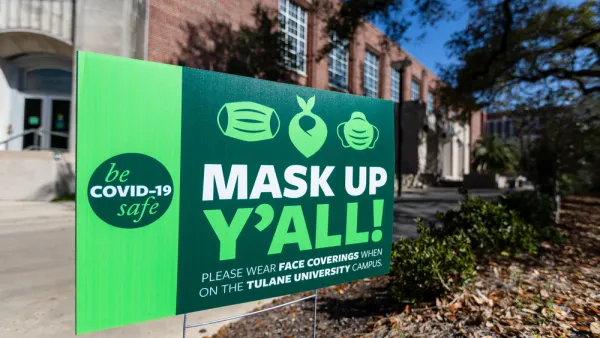“All of us have a date with omicron,” Dr. Amesh Adalja, a senior scholar at the Johns Hopkins Center for Health Security, told The Associated Press on Dec. 20, adding "...and the best way you can encounter this is to be fully vaccinated.”

Two days after the Omicron variant was first identified by South African scientists on Thanksgiving, Dr. Ashish Jha, dean of the Brown School of Public Health, asked in a New York Times op-ed:
How worrisome is Omicron? There are three key questions that help scientists understand how consequential any variant might be.
Jha points to three traits that determine how worrisome a variant will be to mankind: transmissibility, virulence, "[a]nd third, will it render our immune defenses — from vaccines and prior infections — less effective (a phenomenon known as immune escape)."
The U.S. Centers for Disease Control and Prevention (CDC) amplifies Jha's points in an explainer (as of Dec. 20) for its forecast on the Omicron wave:
Infections with the recently identified Omicron variant of SARS-CoV-2, the virus that causes COVID-19, are exponentially increasing in multiple countries. Increases in infections are most likely due to a combination of two factors: increased transmissibility and the ability of the variant to evade immunity conferred by past infection or vaccination (i.e., immune evasion).
Though the precise contribution of each of the two factors remains unknown, a substantial degree of immune evasion is likely as has been demonstrated in early in vitro studies.
Adalja's warning
And that brings us to Adalja's warning, quoted by Mike Stobbe, a national medical writer for The Associated Press and professor at the University of North Carolina's Gillings School Of Global Public Health in an article about Omicron's out-competing the Delta variant, reflected by a six-fold increase of Omicron's share of infections in the week ending Dec. 20, accounting for 73% of new infections.
“All of us have a date with omicron,” said Dr. Amesh Adalja, a senior scholar at the Johns Hopkins Center for Health Security. “If you’re going to interact with society, if you’re going to have any type of life, omicron will be something you encounter, and the best way you can encounter this is to be fully vaccinated."
"We're all going to get this"
Adalja pointed to three countries to watch where Omicron had already become dominant: South Africa, the U.K., and Denmark. In a related post centered on Denmark's renowned Statens Serum Institut, Arieh Cohen, head of development at the lab that processes test results and conducts the initial variant analysis, tells The Washington Post's Rome-bureau chief, Chico Harlan:
“It’s moving so fast,” Cohen said, as more swabs arrived at the lab below his second-floor office. He said his chief concern was to keep things running. He called himself a “lab guy,” and said thinking about the bigger picture was for the epidemiologists. But he ventured: “I can’t help but have a fatalistic opinion: that we’re all going to get this.”
Adalja, who is an infectious disease expert, warned of rapid spread during the holidays, resulting in breakthrough infections among the fully vaccinated in the U.S. and more serious illness among the unvaccinated that could threaten to overwhelm hospitals, particularly those that are already inundated with patients who were infected with the Delta variant.
Two health metrics to watch closely
Jha, appearing on a Sunday show on Dec. 26, updated his guidance on the new variant as the U.S. climbs the steep slope of Omicron’s epidemic curve, reinforcing Adalja's predictions. Dominick Mastrangelo of The Hill reports:
“For two years, infections always preceded hospitalizations which preceded deaths, so you could look at infections and know what was coming," Ashish K. Jha, dean of Brown University and a former Harvard health expert said during an appearance on ABC's "This Week" on Sunday. "Omicron changes that. This is the shift we’ve been waiting for in many ways."
The country has shifted, Jha said, to a place where people who are vaccinated and especially those who have received a booster shot "are gonna bounce back" if they become infected with the coronavirus...
Jha said it remains important that health officials track infections among non-vaccinated individuals "because those people will end up in the hospital."
"But we really need to focus on hospitalizations and deaths now," he said.
Jha added to his analysis on Monday, telling CNN's Jake Tapper, "That separation between infections and hospitalizations is essentially the transition we've been waiting for as we go from an acute phase of this pandemic towards more of an endemic phase."
Coronavirus update in U.S.
Here's where the U.S. is in the pandemic on Dec. 27, following Jha's guidance. The New York Times coronavirus tracker shows:
- Cases: 7-day average of 243,000 or 73 per 100,000 people, +105% in past 2 weeks
- Hospitalizations: 7-day average of 71,000 or 22 per 100,000, +6% in past 2 weeks
- Deaths: 7-day average of 1,200 or 0.40 per 100,000 people, [–5%] in past 2 weeks
If (when?) you test positive
On Monday, CDC shortened "the recommended time for isolation from 10 days for people with COVID-19 to 5 days, if asymptomatic, followed by 5 days of wearing a mask when around others," states their press release on Dec. 27.
The change is motivated by science demonstrating that the majority of SARS-CoV-2 transmission occurs early in the course of illness, generally in the 1-2 days prior to onset of symptoms and the 2-3 days after.
However, it's apparent that the widespread disruption caused by projections of massive infections during the Omicron wave, potentially a million a day in the U.S. played a major factor.
“The Omicron variant is spreading quickly and has the potential to impact all facets of our society,” said Dr. Rochelle Walensky, the director of the Centers for Disease Control and Prevention," reports The New York Times.
In addition, quarantine guidance for anyone exposed to COVID-19 has been changed. In potentially what could be a sign of a possible change to the definition of "fully vaccinated," CDC applies the same quarantine guidelines to the unvaccinated and the unboosted who are 6-months out from their second shot.
Related in Planetizen:
- Coronavirus Geography: Denmark May Be an Omicron Harbinger, Dec. 27, 2021
- Public Health Experts Question CDC Catchphrase, 'Pandemic of the Unvaccinated,' Sept. 9, 2021
- Post-Pandemic: Living with COVID, January 31, 2021
- 'We are Entering the Steep Slope of the Epidemic Curve,' November 1, 2020
FULL STORY: Health expert: Surge in COVID-19 cases should no longer be 'major metric' of pandemic

National Parks Layoffs Will Cause Communities to Lose Billions
Thousands of essential park workers were laid off this week, just before the busy spring break season.

Retro-silient?: America’s First “Eco-burb,” The Woodlands Turns 50
A master-planned community north of Houston offers lessons on green infrastructure and resilient design, but falls short of its founder’s lofty affordability and walkability goals.

Delivering for America Plan Will Downgrade Mail Service in at Least 49.5 Percent of Zip Codes
Republican and Democrat lawmakers criticize the plan for its disproportionate negative impact on rural communities.

Test News Post 1
This is a summary

Test News Headline 46
Test for the image on the front page.

Balancing Bombs and Butterflies: How the National Guard Protects a Rare Species
The National Guard at Fort Indiantown Gap uses GIS technology and land management strategies to balance military training with conservation efforts, ensuring the survival of the rare eastern regal fritillary butterfly.
Urban Design for Planners 1: Software Tools
This six-course series explores essential urban design concepts using open source software and equips planners with the tools they need to participate fully in the urban design process.
Planning for Universal Design
Learn the tools for implementing Universal Design in planning regulations.
EMC Planning Group, Inc.
Planetizen
Planetizen
Mpact (formerly Rail~Volution)
Great Falls Development Authority, Inc.
HUDs Office of Policy Development and Research
NYU Wagner Graduate School of Public Service




























